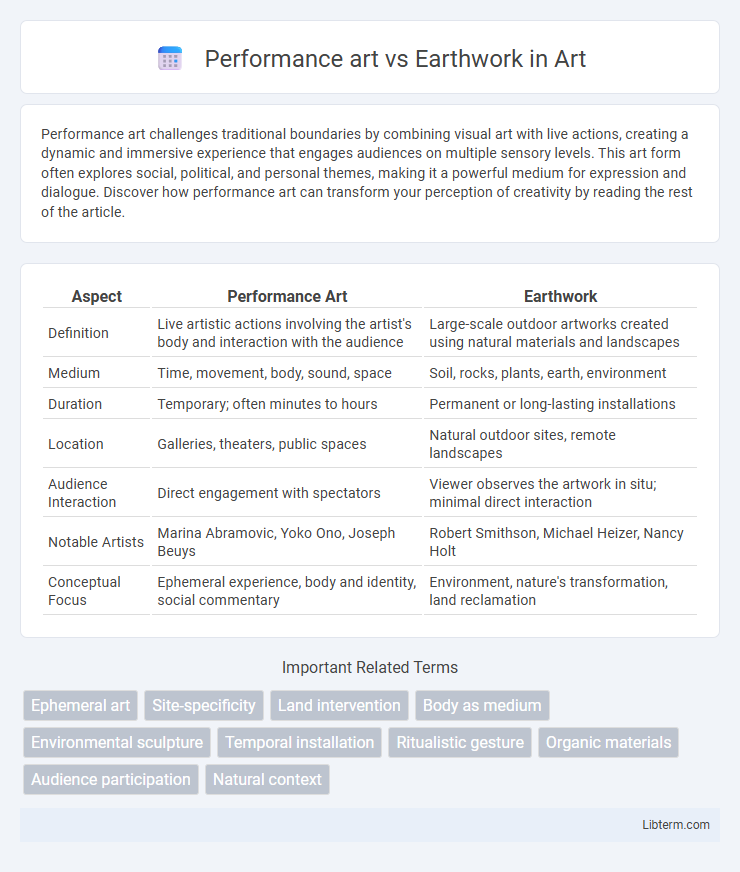Performance art challenges traditional boundaries by combining visual art with live actions, creating a dynamic and immersive experience that engages audiences on multiple sensory levels. This art form often explores social, political, and personal themes, making it a powerful medium for expression and dialogue. Discover how performance art can transform your perception of creativity by reading the rest of the article.
Table of Comparison
| Aspect | Performance Art | Earthwork |
|---|---|---|
| Definition | Live artistic actions involving the artist's body and interaction with the audience | Large-scale outdoor artworks created using natural materials and landscapes |
| Medium | Time, movement, body, sound, space | Soil, rocks, plants, earth, environment |
| Duration | Temporary; often minutes to hours | Permanent or long-lasting installations |
| Location | Galleries, theaters, public spaces | Natural outdoor sites, remote landscapes |
| Audience Interaction | Direct engagement with spectators | Viewer observes the artwork in situ; minimal direct interaction |
| Notable Artists | Marina Abramovic, Yoko Ono, Joseph Beuys | Robert Smithson, Michael Heizer, Nancy Holt |
| Conceptual Focus | Ephemeral experience, body and identity, social commentary | Environment, nature's transformation, land reclamation |
Introduction to Performance Art and Earthwork
Performance art emphasizes live, ephemeral actions by artists that often engage audiences directly, blurring boundaries between art and life. Earthwork, also known as land art, involves large-scale outdoor installations crafted from natural materials, permanently altering landscapes to highlight environmental and spatial relationships. Both movements emerged in the 1960s and 1970s as radical departures from traditional gallery art, emphasizing process, context, and interaction with the environment.
Historical Origins of Performance Art
Performance art originated in the early 20th century, influenced by Dadaism and Futurism, emphasizing ephemeral, live actions that challenge traditional art forms. Its evolution was marked by figures like Marcel Duchamp and later Allan Kaprow, who introduced "Happenings" in the 1950s, blending visual arts with theatrical performance. Earthwork, emerging in the 1960s, contrasts with Performance art by focusing on large-scale environmental sculptures that interact permanently with natural landscapes.
The Evolution of Earthwork Movements
Earthwork movements evolved from performance art by emphasizing permanent or site-specific interventions in natural landscapes rather than ephemeral body-centered actions. Artists like Robert Smithson and Nancy Holt pioneered earthworks that transform environments through large-scale sculptures and land modifications, contrasting with the temporal nature of performance art. This shift highlights a growing ecological awareness and a commitment to integrating artistic expression with environmental context.
Key Characteristics of Performance Art
Performance art emphasizes live, ephemeral actions by artists, often involving audience interaction and challenging traditional art boundaries. It prioritizes time, movement, and the human body as central mediums, creating transient experiences that cannot be replicated. Unlike Earthwork, which manipulates natural landscapes, Performance art is rooted in temporal presence and conceptual expression.
Defining Elements of Earthwork
Earthwork art is characterized by its integration with natural landscapes, using materials like soil, rocks, and vegetation to create large-scale installations that alter the environment. Unlike performance art, which centers on live actions and temporal experiences, earthworks emphasize permanence, spatial transformation, and ecological context. Key elements include site specificity, environmental interaction, and the physical manipulation of terrain.
Influential Artists in Performance Art
Performance art pioneers such as Marina Abramovic redefined the relationship between artist and audience through endurance and interactive pieces, while Joseph Beuys integrated political activism and symbolism into his performances, establishing lasting influence. Laurie Anderson's innovative use of technology and multimedia expanded the boundaries of performance art, blending narrative, music, and visual art to create immersive experiences. These artists collectively shaped contemporary performance art by emphasizing presence, process, and social commentary over traditional art forms.
Pioneers and Innovators of Earthwork
Robert Smithson and Michael Heizer stand as pioneering figures in Earthwork, transforming natural landscapes into monumental art pieces that challenge traditional gallery boundaries. Smithson's "Spiral Jetty" and Heizer's "Double Negative" emphasize the interaction between human creativity and the environment, highlighting the temporal and spatial dimensions of Earthworks. Their innovations paved the way for environmental art, integrating geological processes and ecological awareness within artistic expression.
Audience Engagement: Performance Art vs Earthwork
Performance art offers direct, immersive audience engagement through live actions, sensory experiences, and interactive participation, creating an immediate emotional and intellectual connection. Earthwork, often site-specific and integrated into natural landscapes, engages audiences more contemplatively, encouraging physical exploration and reflection over time. The contrast lies in performance art's ephemeral, immediate interaction versus earthwork's enduring, environmental dialogue with its audience.
Environmental Impact and Sustainability
Performance art often generates minimal environmental impact due to its ephemeral nature, relying on human presence rather than permanent materials. Earthwork, conversely, involves altering landscapes which can result in significant ecological disruption but also offers opportunities for environmental restoration through sustainable design. Sustainable earthworks integrate native vegetation and natural processes, minimizing carbon footprint and promoting long-term ecosystem health.
Contemporary Trends and Future Directions
Performance art increasingly incorporates digital technology and immersive experiences, emphasizing audience interaction and ephemeral moments that challenge traditional art forms. Earthwork, or land art, is expanding through eco-conscious practices and large-scale, site-specific installations that address environmental issues and sustainability. Future directions in both fields highlight interdisciplinary approaches, integrating virtual reality, climate activism, and community engagement to redefine the relationship between art, nature, and society.
Performance art Infographic

 libterm.com
libterm.com